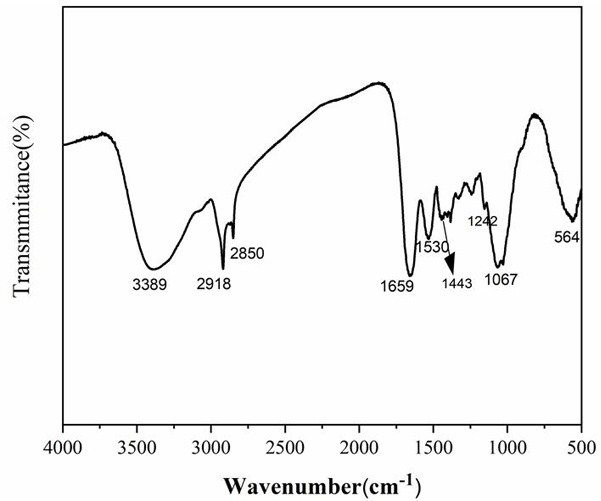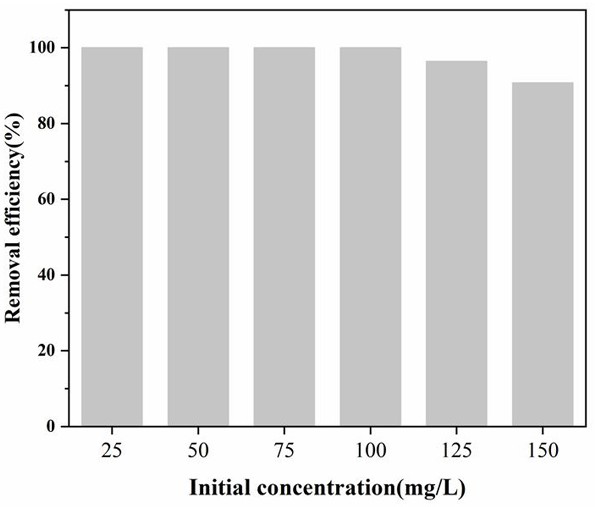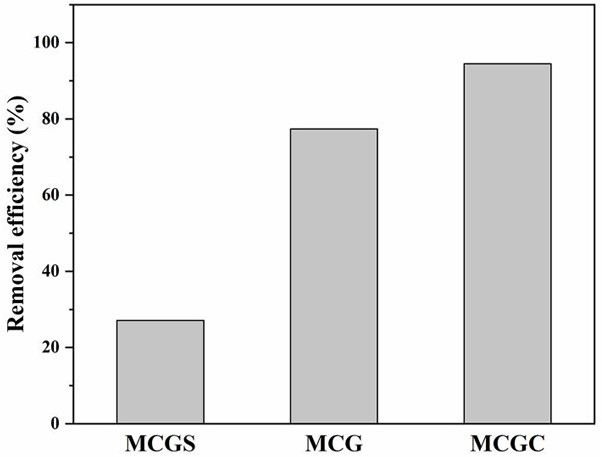Magnetic adsorbent and preparation method thereof
A magnetic adsorbent and adsorbent technology, applied in chemical instruments and methods, adsorption water/sewage treatment, other chemical processes, etc., can solve problems such as easy loss, high use cost, and difficult regeneration
- Summary
- Abstract
- Description
- Claims
- Application Information
AI Technical Summary
Problems solved by technology
Method used
Image
Examples
Embodiment 1
[0021] A magnetic biosorbent with high adsorption capacity and a preparation method thereof, comprising the following steps:
[0022] (1) Preparation of carboxylated Fe by solvothermal method 3 o 4 magnetic nanoparticles. Weigh 0.4 g sodium citrate, 2.70 g FeCl 3 ·6H 2 O and 7.40 g of ammonium acetate were placed in a 250 mL three-necked flask, then added to 75 mL of ethylene glycol, and ultrasonically treated for 30 min to obtain a yellow mixture solution. The three-necked flask was transferred to an oil bath, and N 2 , heated to 170 °C, and mechanically stirred at constant temperature for 1 h to obtain a reddish-brown solution. Then the solution was transferred to a reaction kettle and placed in an oven at 200 °C for 16 h. After the reaction was completed, the reactor was taken out and cooled to room temperature, the product was separated by a magnet, washed three times with ethanol and water respectively, and the washed product was vacuum-dried at 50 °C for 24 h.
[0...
Embodiment 2
[0026] A magnetic biosorbent with high adsorption capacity and a preparation method thereof, comprising the following steps:
[0027] (1) Preparation of carboxylated Fe by solvothermal method 3 o 4 magnetic nanoparticles. Weigh 0.4 g sodium citrate, 2.70 g FeCl 3 ·6H 2 O and 7.40 g of ammonium acetate were placed in a 250 mL three-necked flask, then added to 75 mL of ethylene glycol, and ultrasonically treated for 30 min to obtain a yellow mixture solution. The three-necked flask was transferred to an oil bath, and N 2 , heated to 170 °C, and mechanically stirred at constant temperature for 1 h to obtain a reddish-brown solution. Then the solution was transferred to a reaction kettle and placed in an oven at 200 °C for 16 h. After the reaction was completed, the reactor was taken out and cooled to room temperature, the product was separated by a magnet, washed three times with ethanol and water respectively, and the washed product was vacuum-dried at 50 °C for 24 h.
[0...
Embodiment 3
[0031] A magnetic biosorbent with high adsorption capacity and a preparation method thereof, comprising the following steps:
[0032] (1) Preparation of carboxylated Fe by solvothermal method 3 o 4 magnetic nanoparticles. Weigh 0.4 g sodium citrate, 2.70 g FeCl 3 ·6H 2 O and 7.40 g of ammonium acetate were placed in a 250 mL three-necked flask, then added to 75 mL of ethylene glycol, and ultrasonically treated for 30 min to obtain a yellow mixture solution. The three-necked flask was transferred to an oil bath, and N 2 , heated to 170 °C, and mechanically stirred at constant temperature for 1 h to obtain a reddish-brown solution. Then the solution was transferred to a reaction kettle and placed in an oven at 200 °C for 16 h. After the reaction was completed, the reactor was taken out and cooled to room temperature, the product was separated by a magnet, washed three times with ethanol and water respectively, and the washed product was vacuum-dried at 50 °C for 24 h.
[0...
PUM
 Login to View More
Login to View More Abstract
Description
Claims
Application Information
 Login to View More
Login to View More - R&D
- Intellectual Property
- Life Sciences
- Materials
- Tech Scout
- Unparalleled Data Quality
- Higher Quality Content
- 60% Fewer Hallucinations
Browse by: Latest US Patents, China's latest patents, Technical Efficacy Thesaurus, Application Domain, Technology Topic, Popular Technical Reports.
© 2025 PatSnap. All rights reserved.Legal|Privacy policy|Modern Slavery Act Transparency Statement|Sitemap|About US| Contact US: help@patsnap.com



